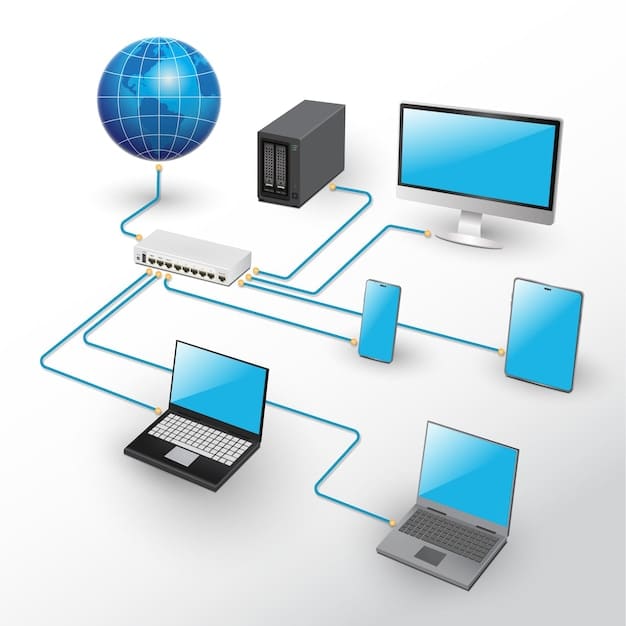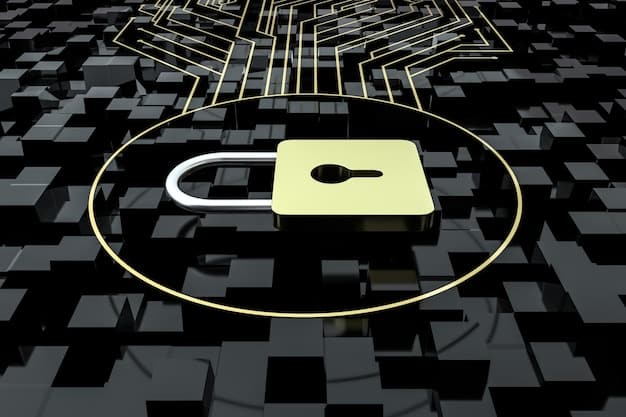Secure Your Home Network: A Complete Privacy Guide

Advertisements
Setting up a secure home network to protect your data and privacy involves securing your router, creating strong passwords, enabling encryption, and keeping your devices updated to shield against cyber threats and unauthorized access.
In today’s digital age, safeguarding your personal data and maintaining privacy within your home network is more crucial than ever. Learning how to set up a secure home network to protect your data and privacy is a fundamental step towards ensuring your digital well-being and peace of mind.
Advertisements
Understanding the Basics of Home Network Security
Before diving into the technical aspects, it’s essential to grasp the fundamental principles that underpin a secure home network. These principles involve understanding potential threats and vulnerabilities, and recognizing the importance of proactive measures to mitigate risks.
This involves not only securing your Wi-Fi network but also ensuring that all devices connected to it are protected.
Advertisements
Identifying Potential Threats
Understanding the types of threats that could compromise your home network is the first step in securing it. These threats range from simple password breaches to more sophisticated hacking attempts.
- Weak Passwords: Easily guessable passwords are a primary entry point for attackers.
- Unsecured Wi-Fi: Open or poorly secured Wi-Fi networks allow unauthorized access to your internet connection and connected devices.
- Malware: Malicious software can infect devices and steal personal information or disrupt network operations.
- Phishing: Deceptive emails or websites can trick you into revealing sensitive data.
By identifying these common threats, you can start to implement targeted security measures to protect your home network.

The Importance of a Secure Router
The router is the gateway to your home network and the first line of defense against external threats. Configuring your router correctly can dramatically enhance the security of your entire network.
A secure router acts as a firewall, inspecting incoming and outgoing network traffic and blocking suspicious activity.
Securing your router involves setting a strong admin password, updating the firmware regularly, and disabling unnecessary features.
With a solid understanding of the basics, you’re ready to take the necessary steps to safeguard your home network.
Securing Your Router: The Foundation of Network Security
Securing your router is arguably the most critical step in setting up a secure home network. This involves several key actions that can significantly enhance your network’s defenses against cyber threats.
A well-secured router acts as a barrier, preventing unauthorized access and protecting your connected devices.
Changing the Default Password
One of the first things you should do when setting up your router is to change the default password. Default passwords are widely known and easily exploited by attackers.
- Choose a Strong Password: Use a combination of upper and lowercase letters, numbers, and symbols.
- Avoid Personal Information: Don’t use names, birthdays, or other easily guessable information.
- Regularly Update Your Password: Change your password every few months to maintain security.
A strong, unique password is the first line of defense against unauthorized access to your router settings.
Updating Router Firmware
Keeping your router’s firmware up to date is essential for patching security vulnerabilities and improving performance. Firmware updates often include critical fixes that protect your network from known exploits.
Most modern routers have an automatic update feature that you can enable. Check your router’s settings to see if this option is available.
Regular firmware updates ensure that your router is equipped with the latest security measures.
Disabling Remote Access
Remote access allows you to manage your router from outside your home network. While convenient, it also presents a security risk if not properly secured.
Unless you specifically need remote access, it’s best to disable this feature to reduce the attack surface of your router.
By disabling remote access, you minimize the risk of unauthorized users gaining control of your router.
By taking these steps to secure your router, you lay a strong foundation for protecting your entire home network.
Creating Strong Passwords and Using Encryption
Beyond securing your router, creating strong passwords for all your online accounts and enabling encryption are crucial for protecting your data and privacy. These measures help to prevent unauthorized access and ensure that your data remains confidential.
Strong passwords and encryption work together to provide a robust defense against cyber threats.
Password Management Best Practices
Effective password management is essential for maintaining online security. This involves not only creating strong passwords but also storing them securely and avoiding reuse.
- Use a Password Manager: A password manager can generate and store strong, unique passwords for all your accounts.
- Avoid Password Reuse: Never use the same password for multiple accounts. If one account is compromised, all others are at risk.
- Enable Two-Factor Authentication (2FA): 2FA adds an extra layer of security by requiring a second verification method, such as a code sent to your phone.
Implementing these password management practices can significantly reduce the risk of your accounts being compromised.
Understanding Encryption
Encryption is the process of converting data into a coded format that is unreadable without the correct decryption key. It is a fundamental tool for protecting sensitive information.
When data is encrypted, it is scrambled in a way that makes it unintelligible to anyone who does not have the key to decrypt it.
Encryption is used to protect data both in transit (e.g., when sending emails) and at rest (e.g., when storing files on your computer).
By encrypting your data, you ensure that even if it falls into the wrong hands, it cannot be easily read or used.

Enabling Wi-Fi Encryption (WPA3)
Wi-Fi encryption protects the data transmitted over your wireless network. The latest standard, WPA3 (Wi-Fi Protected Access 3), offers improved security compared to older standards like WPA2 and WEP.
To enable WPA3, access your router’s settings and look for the wireless security options. Choose WPA3-Personal (or WPA3-SAE) if available.
If your router does not support WPA3, use WPA2-AES as the next best option.
Enabling Wi-Fi encryption ensures that your wireless communications are protected from eavesdropping.
By creating strong passwords and using encryption, you add layers of security to your home network, protecting your data from unauthorized access and interception.
Securing Your Devices and IoT Gadgets
Beyond the router and passwords, securing your individual devices and Internet of Things (IoT) gadgets is crucial. Each device connected to your network represents a potential entry point for attackers, making it essential to take proactive security measures.
Securing your devices involves keeping software up to date, enabling security features, and being mindful of privacy settings.
Keeping Software Updated
Regular software updates provide critical security patches that protect your devices from known vulnerabilities. This includes operating systems, web browsers, and other applications.
- Enable Automatic Updates: Most operating systems and applications offer automatic update features. Enable these to ensure that your software is always up to date.
- Install Updates Promptly: When updates are available, install them as soon as possible to patch security vulnerabilities.
- Be Wary of Suspicious Updates: Only download updates from trusted sources to avoid installing malware.
Keeping your software updated ensures that your devices are protected against the latest security threats.
Securing IoT Devices
IoT devices, such as smart TVs, security cameras, and smart home assistants, often have weak security features, making them vulnerable to attack. Securing these devices is essential to prevent them from being used as entry points into your network.
Change the default passwords on all IoT devices to strong, unique passwords.
Disable unnecessary features, such as remote access, if you don’t need them.
Managing Privacy Settings
Reviewing and managing the privacy settings on your devices and online accounts can help to protect your personal information. Many apps and services collect data about your usage habits, which can be used for targeted advertising or other purposes.
Adjust your privacy settings to limit the amount of data that is collected about you.
By securing your devices and managing your privacy settings, you reduce the risk of your personal information being compromised.
Taking these steps to protect your individual devices and IoT gadgets contributes to the overall security of your home network.
Monitoring Your Network and Detecting Intrusions
Even with robust security measures in place, it’s important to monitor your network for suspicious activity and detect potential intrusions. This proactive approach allows you to identify and respond to threats before they can cause significant damage.
Network monitoring involves analyzing network traffic, checking logs, and using security tools to detect anomalies.
Analyzing Network Traffic
Analyzing network traffic involves monitoring the data flowing in and out of your network. This can help you to identify unusual patterns or suspicious activity that may indicate a security breach.
Use network monitoring tools to track bandwidth usage, identify connected devices, and detect unusual traffic patterns.
Regularly review your network traffic logs to look for suspicious activity.
By analyzing network traffic, you can gain valuable insights into the security of your home network.
Checking Router and Device Logs
Routers and devices often maintain logs that record network activity and security events. Checking these logs can provide valuable information about potential intrusions or security breaches.
Review your router’s logs regularly to look for signs of unauthorized access or suspicious activity.
Be aware of what constitutes normal activity so you can quickly identify anomalies.
By checking your router and device logs, you can identify and respond to security incidents more quickly.
Using Security Software and Tools
A variety of security software and tools are available to help you monitor your network and detect intrusions. These tools can provide real-time protection and alerts for suspicious activity.
Consider using a network intrusion detection system (NIDS) to monitor your network for malicious traffic.
Use antivirus and anti-malware software on all your devices to protect against malware infections.
By using security software and tools, you can enhance your ability to detect and respond to security threats.
Monitoring your network and detecting intrusions are essential for maintaining a secure home network over time.
Regular Security Audits and Maintaining Vigilance
Securing your home network is not a one-time task but an ongoing process that requires regular security audits and maintaining vigilance. As new threats emerge and technology evolves, it’s essential to continually assess and update your security measures.
Regular security audits involve reviewing your security settings, updating software, and educating yourself about the latest threats.
Performing Periodic Security Audits
Set aside time to conduct periodic security audits of your home network. This involves reviewing your router settings, password policies, and device security configurations.
Review your router settings to ensure that they are still configured correctly and that no unauthorized changes have been made.
Assess the security of your passwords and update them if necessary.
Monitor the security of your IoT devices and update their firmware as needed.
By performing regular security audits, you can identify and address potential vulnerabilities before they can be exploited.
Staying Informed About Emerging Threats
Stay informed about the latest security threats and vulnerabilities by following reputable security news sources and blogs.
Subscribe to security alerts and newsletters to receive updates about new threats and security best practices.
Understand the risks associated with different types of attacks, such as phishing, malware, and ransomware.
By staying informed, you can anticipate and prepare for new security challenges.
Educating Household Members
Educate all members of your household about security best practices. This includes choosing strong passwords, avoiding phishing scams, and being cautious about downloading software from untrusted sources.
Teach children and teenagers about the risks of online predators and the importance of protecting their personal information.
Explain the importance of using secure Wi-Fi networks and avoiding public Wi-Fi hotspots when possible.
By educating household members, you create a culture of security awareness that helps to protect your entire home network.
Regular security audits and maintaining vigilance are essential for ensuring the long-term security of your home network.
| Key Point | Brief Description |
|---|---|
| 🔑 Strong Passwords | Use complex, unique credentials for all accounts to prevent unauthorized access. |
| 🛡️ Router Security | Secure your router with firmware updates and disable remote management to block intrusions. |
| 📡 Encryption | Enable WPA3 for Wi-Fi and encrypt sensitive data to protect against eavesdropping. |
| 📱 Device Updates | Keep all devices updated with the latest software to patch security vulnerabilities. |
Frequently Asked Questions
Securing your home network protects your personal data from cyber threats, such as hacking and identity theft. It also prevents unauthorized access to your devices and ensures privacy.
It’s recommended to change your Wi-Fi password every three to six months. This practice reduces the risk of unauthorized access and keeps your network secure from potential breaches.
WPA3 is the latest Wi-Fi security protocol that offers enhanced encryption and authentication compared to older standards like WPA2. Using WPA3 improves your network’s resistance to password cracking.
Secure your IoT devices by changing default passwords, disabling unnecessary features, and keeping their firmware updated. Regularly monitor these devices for any suspicious network activity.
If you suspect your network has been compromised, immediately change your Wi-Fi password, update your router’s firmware, and run a full system scan on all connected devices to detect and remove malware.
Conclusion
In conclusion, setting up a secure home network to protect your data and privacy requires a multi-faceted approach that includes securing your router, creating strong passwords, enabling encryption, keeping your devices updated, and staying vigilant against emerging threats. By implementing these measures, you can significantly reduce the risk of cyberattacks and ensure the confidentiality, integrity, and availability of your personal information.